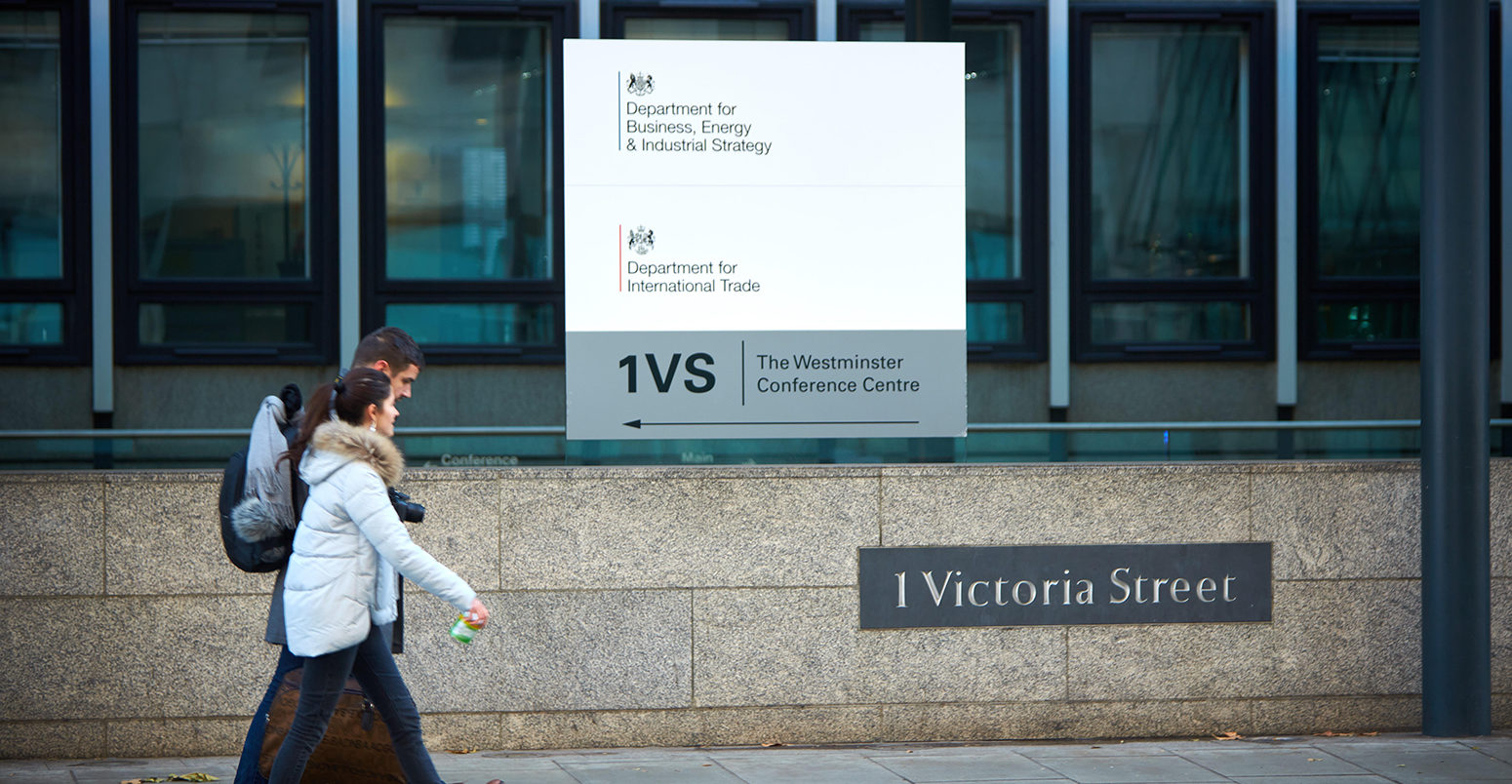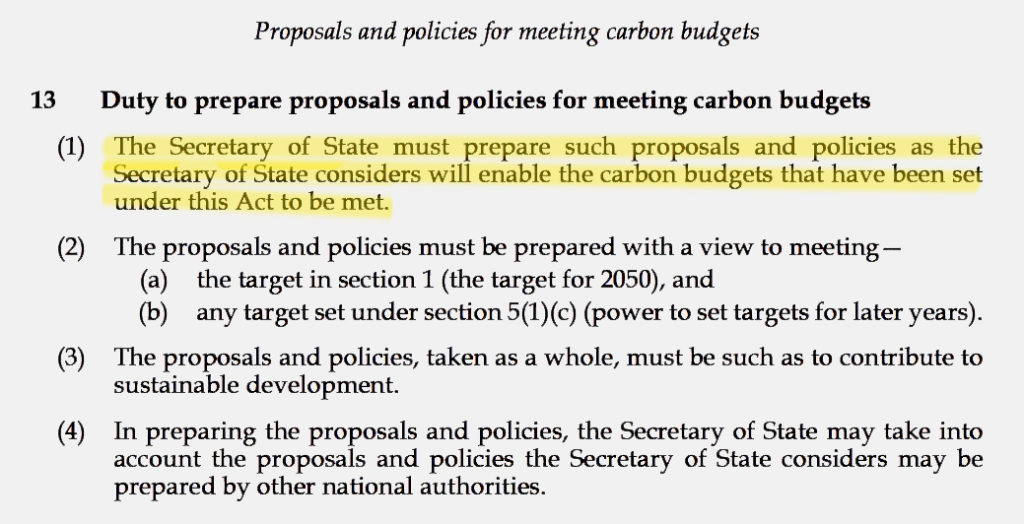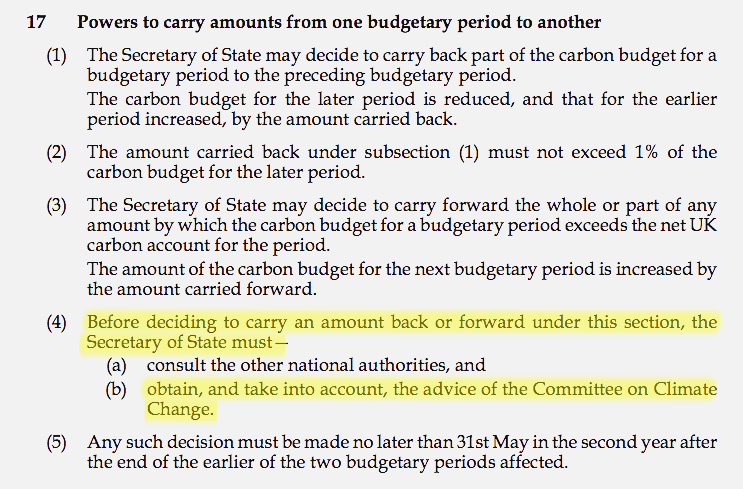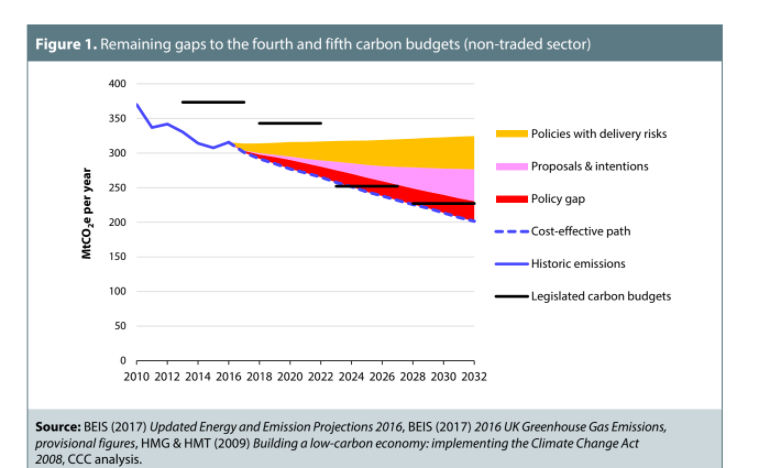
UK will miss climate goals despite new strategy, says official watchdog
Simon Evans
01.17.18Simon Evans
17.01.2018 | 12:01amThe UK will miss its legally binding climate goals without more ambitious policies, says the Committee on Climate Change (CCC).
The UK’s official climate watchdog says the government’s Clean Growth Strategy falls short, even when taking a “generous” view of the plans and policies it sets out. The strategy was published in October 2017 and is supposed to meet the UK’s fourth and fifth carbon budgets for 2023-2032.
There are gaps in policy for cutting emissions across the economy, from the power sector to industry, transport and farming. Even the policies in place risk not delivering, the CCC says.
In a statement, CCC chair Lord Deben praises the tone of the government’s plans, but adds: “Ambitions alone are not enough. As it stands, the strategy does not deliver.”
This verdict leaves the government at risk of legal challenge under the Climate Change Act 2008, which says ministers must plan to meet UK carbon budgets.
Meeting carbon budgets
The 2008 Climate Change Act (pdf) sets a legally binding framework for UK climate policy. Under the act, the government must set five-yearly carbon budgets towards a long-term goal of cutting greenhouse gas emissions by “at least” 80% below 1990 levels in 2050.
Most recently, parliament legislated for a 57% cut in emissions across the fifth carbon budget, covering 2028-2032. The act also obliges ministers to set out how the UK will meet its goals.
Section 13, below, says the government: “Must prepare such proposals and policies as [it] considers will enable the carbon budgets…to be met.”

Section 13 of the Climate Change Act 2008. (pdf)
Under section 14, ministers must set out their plans “as soon as is reasonably practicable” after each carbon budget is set. This is why the government published its Clean Growth Strategy in October 2017, after repeated delays.
Today, the CCC issues its verdict – saying the strategy falls short of meeting the fourth and fifth carbon budgets – with a press release that quotes section 13 of the Act.
At a briefing for journalists, Carbon Brief asked Lord Deben if, in the committee’s view, the strategy was in breach of this provision. He said:
“These requirements have got to be met…[ministers are] going to have to fill [the strategy] out and they’re going to have to fill it out in time for us to meet the fourth and fifth carbon budget.”
The CCC’s verdict is also at odds with recent statements to parliament, in which climate minister Claire Perry said the policies in the strategy “keep us on track to meet our carbon budgets”.
Banking on flexibility
One point of particular contention is the use of flexibility rules. Under section 17 of the act, below, ministers can “bank” overachievement in one carbon budget to help meet subsequent goals.
These powers are relatively unrestricted, save for a requirement to obtain advice from the CCC and to take account of that advice (see paragraph 4, below).

Section 17 of the Climate Change Act 2008. (pdf)
In its Clean Growth Strategy (pdf), the government highlighted this flexibility, noting: “There is currently sufficient projected surplus available [from the first three carbon budgets] to carry forward to meet the fourth carbon budget and some of the fifth carbon budget.”
However, the CCC pushes back strongly against any plan that relies on this banked surplus to meet a shortfall in future carbon budgets.
It says that the current UK surplus stems largely from changes to the UK’s share of the EU Emissions Trading System (EU ETS) and the 2008 financial crisis, not from early climate action. If the UK relies on this surplus to meet targets in the short term, it would delay the low-carbon transition and store up greater costs later on.
The CCC report says:
“These [flexibilities] should only be employed in the case of unexpected conditions that, despite strong policy action, would otherwise cause the carbon budgets to be missed. They should not be used to enable ambition to be weakened…Use of these mechanisms would risk failing to develop leading low-carbon industries in the UK and storing up larger costs for future generations. Their use would also undermine the UK’s position of leadership and be counter to the commitments made under the Paris Agreement.”
Adrian Gault, acting CCC chief executive, tells Carbon Brief: “We shouldn’t be planning now to be using the flexibilities.” He gives the example of a series of very cold winters as a possible reason to use them. It ought to be something “really exceptional, late in the day”, he says.
In the briefing with journalists, Deben said:
“There is no question of using the banking, let’s be absolutely clear…We neither expect [government] to do it, nor would we accept that [government] should do it, because the budgets are not written on that basis. The budgets are written on the basis that there isn’t a carry-forward of that kind. If we were thinking of carry-forward we would have written the budgets differently and parliament would have voted on them differently.”
It is worth repeating that while the government must take the CCC’s advice into account on this matter, it is not obliged to follow that advice. However, the government did follow similar advice in agreeing (pdf) not to carry forward a surplus from the first carbon budget.
It is also worth noting that the first three UK carbon budgets were set on an “interim” basis, with the intention that the third budget for 2018-2022 be raised to a tighter “intended” level if a global climate deal were to be reached. This tightening never happened. It would have cut, though not eliminated the surplus savings, David Joffe, acting head of carbon budgets tells Carbon Brief.
The CCC report says that the UK will need to tighten its targets to align with the 1.5C ambition of the Paris Agreement. It suggests that any extra carbon budget savings should be put towards this. It also says the government should seek its advice on the UK’s long-term targets, once the Intergovernmental Panel on Climate Change releases its report on 1.5C in September.
Generous interpretation
The CCC starts its assessment of the Clean Growth Strategy with praise for the tone of the document. At the briefing for journalists, Deben said: “What the Clean Growth Strategy says, fundamentally, is this a central part of government’s economic policy. In that sense, it’s very welcome…There has been a very fundamental change in stance.”
In a foreword to the CCC report, Deben says these “very positive signals” are not matched in the details of the strategy: “Whilst some new policies are announced in the strategy, the detailed policies and measures to meet the targets are not, in general, set out.”
The report breaks down its assessment into three levels of certainty and detail.
First, it looks at firm policies that are likely to deliver lower emissions. These include £557m in funding to support low-carbon sources of electricity through more auctions, starting in spring 2019.
Second, the CCC lists policies which are already in place, but which risk failing to deliver as expected, potentially leaving gaps in the government’s climate plans. These include the Hinkley C and subsequent new nuclear plants.
The UK’s reliance on EU policies, from product energy efficiency to the EU Emissions Trading System (EU ETS), are also at risk as they may change or cease to apply after the UK leaves the EU.
Third, the CCC looks at broad proposals or intentions in the strategy, where detailed policy is lacking. Examples include a 2040 phaseout of combustion-engine vehicle sales and the aspiration for “as many homes as possible” to reach band C efficiency by 2035.
The CCC adds all of these policies together and assumes each of them delivers in full. It uses a “generous” interpretation of the looser aspirations. Yet it still finds that the UK will miss its climate goals. You can see this “policy gap” between current policies and legal targets in the chart, below.

UK greenhouse gas emissions (blue line) and legally binding carbon budgets (black lines). The path of future emissions (dashed blue line) depends on climate policies already in place but at risk of not delivering (yellow area), as well as proposals and intentions without firm policy (pink). If all these policies deliver in full, the UK will still miss its legislated budgets, with a policy gap remaining (red). Note that the chart only covers sectors outside the EU Emissions Trading System (EU ETS). Source: Committee on Climate Change.
Updated government emissions projections, published earlier this year, cut the policy gap slightly for reasons unrelated to changes in government policy, the CCC notes. More importantly, “there remains a gap”, even with these lower projections. It adds:
“We would not expect a reduction in policy ambition in response…given the risk that this is reversed in later years and given the commitment in the Paris Agreement to increase effort and deliver beyond existing targets.”
On the contrary, the committee says the government should aim to outperform the carbon budgets as currently legislated. This would offer wiggle room in case some policies fail to deliver or allow for higher ambition, in line with Paris.
The CCC says the government should raise its ambition according to a strict timetable. This should eliminate the policy gap for the fourth carbon budget by the end of 2018 and firm up existing plans, so as to largely remove delivery risks, by the end of 2020. Similar assurance is needed on the fifth carbon budget, by the end of 2025.
It says: “If policies are not in place on this timeline, the carbon budgets are liable to be missed.”
Sectoral gaps
The report sets out the key outcomes needed in each sector, to fill in the policy gaps it identifies. In the power sector, for example, the CCC says the government needs to contract an additional 50-70 terawatt hours of low-carbon supplies for delivery during 2025-2030.
For transport, emissions should fall to 44% below 2016 levels by 2030. The government should go beyond its aspirational 2040 goal on combustion engine vehicles, with policies to ensure around 60% of vehicle sales by 2030 are “ultra low emissions”, including electric vehicles.
Emissions from buildings and industry need to fall to 20% below 2016 levels by 2030, with incentives – or potentially regulations – to drive progress. You can see the outcomes needed from each sector in the table, below.
Committee on Climate Change: Independent Assessment of Clean Growth Strategy by Carbon Brief on Scribd
Legal risk
The CCC’s official verdict is that the UK will miss its carbon targets for 2023-2032, without new policies. In the context of the legally binding provisions of the Climate Change Act, this verdict further opens the government to the risk of legal action.
The CCC says the government’s Clean Growth Strategy will fall short, even taking a “generous” interpretation of the plans and policies it contains, many of which remain undeveloped.
The committee also pushes back firmly against any idea that this policy gap could be bridged using flexibilities in the act. Instead, it lists the areas where more detail or ambition will be needed and sets a timetable for government to deliver.
Speaking to Carbon Brief, acting committee chief executive Gault says: “There is still time to put in place necessary policies and measures…we’re not saying the carbon budgets can’t be met.”
When the Clean Growth Strategy was published, legal NGO ClientEarth said: “[This] fails to put us on track to meet legally binding emissions targets. We are considering our legal options.”
This week, in a statement to Carbon Brief, the NGO says:
“Though the Clean Growth Strategy moved things in the right direction, we agree with the CCC that further policy development is urgently needed…The ball remains very firmly in the government’s court to go much further than it has done so far.”

